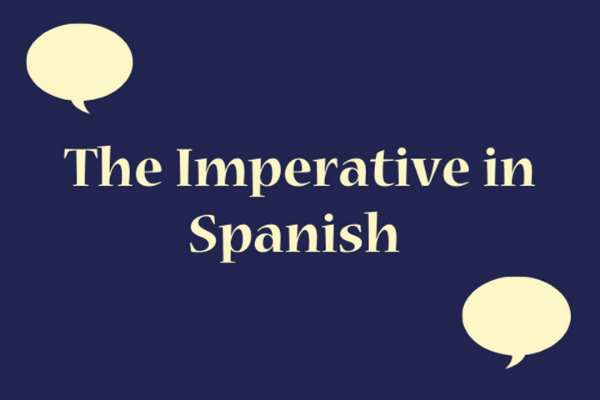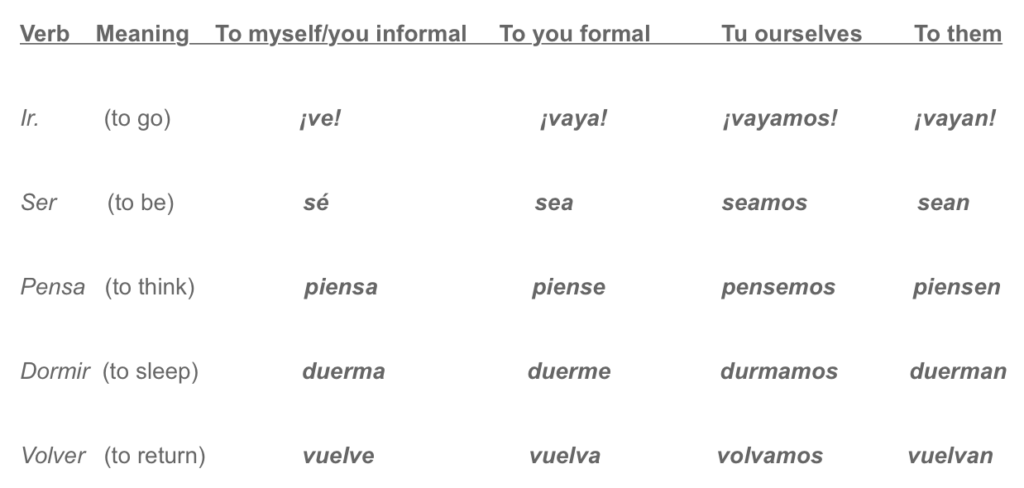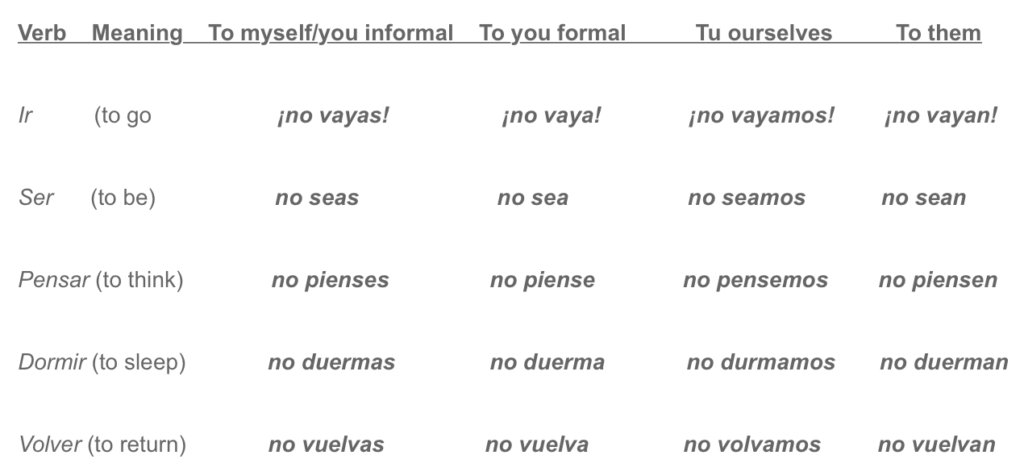The Imperative in Spanish
In English, the imperative, or ‘command’ tense is one of the simplest to learn. To form the imperative, we use the simple verb and make no changes. For example, in the affirmative, it’s simply: ‘Stop!’ or‘Go!’ and in the negative, we just need to add on ‘Don’t’: ‘Don’t stop!’ Don’t go!’ It doesn’t even matter if we’re talking to one person or a group of 100. It’s easy-peasy.
In Spanish, however, it’s quite complex because the imperative has the following tricks you must learn:
The verb not only changes depending on whether it’s an affirmative command or a negative command; you also need to conjugate it to match who you’re speaking with;
There are many irregular verbs that must be memorized* for both the affirmative and negative imperatives;
The negative command requires knowledge of the subjunctive conjugations;
You need to learn the reflexive pronouns and uses**. For example: sientate (sit down - you familiar) or sientese (sit down - you formal); and
Unless you are very close to someone, please add por favor to the end of your imperative request.
Let’s start with the affirmative imperatives or commands and their conjugations.
THE SPANISH AFFIRMATIVE IMPERATIVE
As we like to eat and Mexicans love food and to invite us to join and eat together, let’s learn with the -er and -ir ending verbs by using the verb: comer (to eat).
We've highlighted the endings in blue:
¡Come! /co meh/ (to yourself)
¡Come! (to someone familiar)
¡Coma!/co mah/ (to someone you don’t know or you want to be respectful to)
¡Comamos! /co mah mohs/ (you plus others)
¡Coman! /co mahn/ (you plural)
Por ejemplo: Come tus verduras, por favor.
Please eat your vegetables.
Now, let’s use the -ar verb, nadar (to swim) for this conjugation:
¡Nada! /nah dah/ (to yourself)
¡Nada! (to someone familiar)
¡Nade!/nah deh/ (to someone you don’t know or you want to be respectful to)
¡Nademos! /nah deh mos/ (you plus others )
¡Naden! /nah den/ (you plural)
Por ejemplo: Nada al otro lado por favor.
Please swim to the other side.
*There are many irregular verbs for the affirmative indicative. Unfortunately, there are no specific rules and you need to study, memorize and practice them! Some of the more common irregulars verbs are:
Irregular affirmative imperative verb examples
Por ejemplo:
Por favor ¡piensa en lo que haces!
Please think about what you’re doing!
**Many imperative verbs need to be used with the reflexive in Spanish when making a command. Here are a couple examples:
Reflexive affirmative imperative examples
Por ejemplo:
Niños, ¡duérmanse!
Kids, go to sleep!
NEGATIVE IMPERATIVE
While we command people to do things we also command people to not do things and this is the negative form of the imperative. As previously mentioned, in English, we simply add ‘don’t’ to the simple verb and we’re done but in Spanish, it’s much more complicated.
In order to command someone to NOT do something, we need to conjugate the verb using the subjunctive tense conjugations.
Just as the affirmative conjugations, the -er and -ir verbs conjugate the same. For our example, we’ll use the same verb, comer (to eat):
¡No comas! (you telling yourself)
¡No comas! (telling someone informally)
¡No coma! (telling someone in a respectful way)
¡No comamos! (telling others including yourself)
¡No coman! (telling others not including yourself)
Por ejemplo:
¡No coman esa comida!
Don’t eat that food!
For regular verbs ending in -ar, the conjugation is like this. We’ll use the same verb as above: nadar (to swim):
¡No nades! (you telling yourself)
¡No nades! (telling someone informally)
¡No nade! (telling someone in a respectful way)
¡No nademos! (telling others including yourself)
¡No naden! (telling others not including yourself)
Por ejemplo:
¡No naden en esa laguna!
Don’t swim in that lagoon!
As with the Spanish affirmative imperative, there are irregulars for the negative imperative. These also use the subjunctive conjugation.
Irregular negative imperative verbs
Irregular negative imperative verbs
Por ejemplo:
¡No seas grosera, por favor!
Please don’t be rude!
And, as with the affirmative imperative, many negative imperatives are reflexive. We will just continue with the same two examples from above.
Irregular negative imperative verbs
Por ejemplo:
No te vayas por favor.
Please don’t go.
Would you like to learn more and practice these imperatives with a native-speaking teacher? Well, ¡no esperes! (don’t wait!), ¡Inscríbete ya! (sign up now!).











